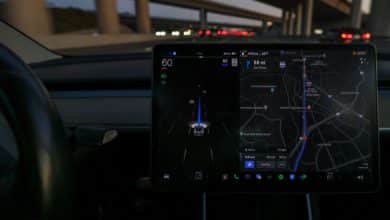Volvo EX30 | A complicated entrance

Volvo management received, in quick succession, two pieces of bad news on the 1ster last October. First, the removal of the Canadian subsidy for battery vehicles built in China. Then, the increase in customs duties imposed on these same vehicles. The EX30, which expected to capture the attention of consumers looking for an all-electric city car, suddenly finds itself less attractive.
Faced with political decisions beyond its control, Volvo must revise its business model. To do this, the EX30 that the Sino-Swedish brand intends for us will take birth in its Belgian facilities starting next year. It remains to be seen what impact this industrial relocation will have on the sale price. Currently, it costs a little over $60,000 to acquire this car.
At this price, many consumers are likely to choose another one that is more spacious, offers more autonomy and, above all, gives access to all government subsidies.
The EX30 presents itself as an alternative to the new electric Mini, the Hyundai Kona EV and the future Chevrolet Bolt. Volvo strategists used a new chassis shared by the latest Smart, not sold in our country. The EX30 can accommodate four people (five, maybe, if squeezed tightly), but headroom is limited. The seat of the bench is short and the support is non-existent. Although easy to access, the trunk has a low appetite for luggage and don't count on the “frunk” (the space provided under the hood) to solve your storage problems. It can barely accept a charging cable.
The EX30 is not a grand tourer, but does not fear highways. Its front axle does not threaten to slip away in curves and its suspension has enough flexibility to smooth out small imperfections in the road surface. Its small size, combined with steering that is both soft and light, makes it an agile vehicle. There is a feeling of fluidity behind the wheel that makes the driving experience quite pleasant.
-
PHOTO PROVIDED BY VOLVO
The Volvo EX30
-
PHOTO PROVIDED BY VOLVO
The interior of the Volvo EX30
-
PHOTO PROVIDED BY VOLVO
The seat of the Volvo EX30
-
PHOTO PROVIDED BY VOLVO
The Volvo EX30
-
PHOTO PROVIDED BY VOLVO
The panoramic roof of the Volvo EX30
-
PHOTO PROVIDED BY VOLVO
The Volvo EX30 console
-
PHOTO PROVIDED BY VOLVO
The trunk of the Volvo EX30
1/7
In its basic configuration (Core), the EX30 drives its rear wheels (propulsion) using a single motor. The “Plus” and “Ultra” versions offer full mode (four-wheel drive) by adding a second engine. This entails an additional outlay of $3,000.
Regardless of the number of engines, this Volvo jumps out at red lights and uses its acceleration capabilities to easily fit into traffic. The silence of operation is barely disturbed by a slight turbine noise when decelerating. We would have liked the latter to be stronger to better modulate one-pedal driving.
The EX30 has a range of around 400 km. A performance that was impossible for us to achieve with the arrival of cold weather. We have never been able to pass the 300 km threshold, even by turning off the cabin heating.
A new era
Minimalist with a Scandinavian flavor, the little Volvo opens its doors onto an austere, vaguely snobbish interior. Once installed, there are also several shortcomings in ergonomics and a distressing bias (some readers may prefer the term distressing) for the digital controls. They are (almost) all grouped together in a screen positioned in the center of an onboard “board” (the word is well chosen). In the event of a malfunction, the car becomes practically unusable.
In addition, the absence of a head-up display regularly forces those behind the wheel to take their eyes off the road (readability is far from excellent). The window controls are located on the deceptively practical armrest. The finish is correct, but the choice of plastics often appears very questionable. Especially considering the asking price.
Faced with the EX30, you have to choose your side: detractor or supporter? Regardless of your answer, we expected more. In North America, at least, it won't improve Volvo's operating profit. To trigger a crush, it's a bit tight. And the price is certainly not cheap and is not an average consistent with electrics of this ilk.
-
PHOTO PROVIDED BY VOLVO
The Volvo EX30
-
PHOTO PROVIDED BY VOLVO
The Volvo EX30
-
PHOTO PROVIDED BY VOLVO
The interior of the Volvo EX30
-
PHOTO PROVIDED BY VOLVO
The seat of the Volvo EX30
-
PHOTO PROVIDED BY VOLVO
The Volvo EX30
-
PHOTO PROVIDED BY VOLVO
The panoramic roof of the Volvo EX30
-
PHOTO PROVIDED BY VOLVO
The Volvo EX30 console
-
PHOTO PROVIDED BY VOLVO
The trunk of the Volvo EX30
1/8
- Make/Model: Volvo EX30
- Price range: $57,238 to $62,638
- Eligible for government subsidies: yes
- Consumption: 18.9 kWh – 20.7 kWh (during the test)
Visit the Volvo website
We love
- Agility in an urban environment
- Soft steering
- Sleek style
We like less
- The infotainment screen controls everything
- Inefficient one-pedal driving
- Disappointing autonomy
Our Verdict
- When technology tries to make us forget that it is first and foremost a car.
Share your experience
The Press will soon publish the test of the following vehicles: Buick Enclave, Chevrolet Equinox EV, Genesis GV80, Land Rover Defender and Mazda CX-50. If you own one of these vehicles or are awaiting delivery, we would love to hear from you.
Write to us




















